Cell Viability Assays Market Size
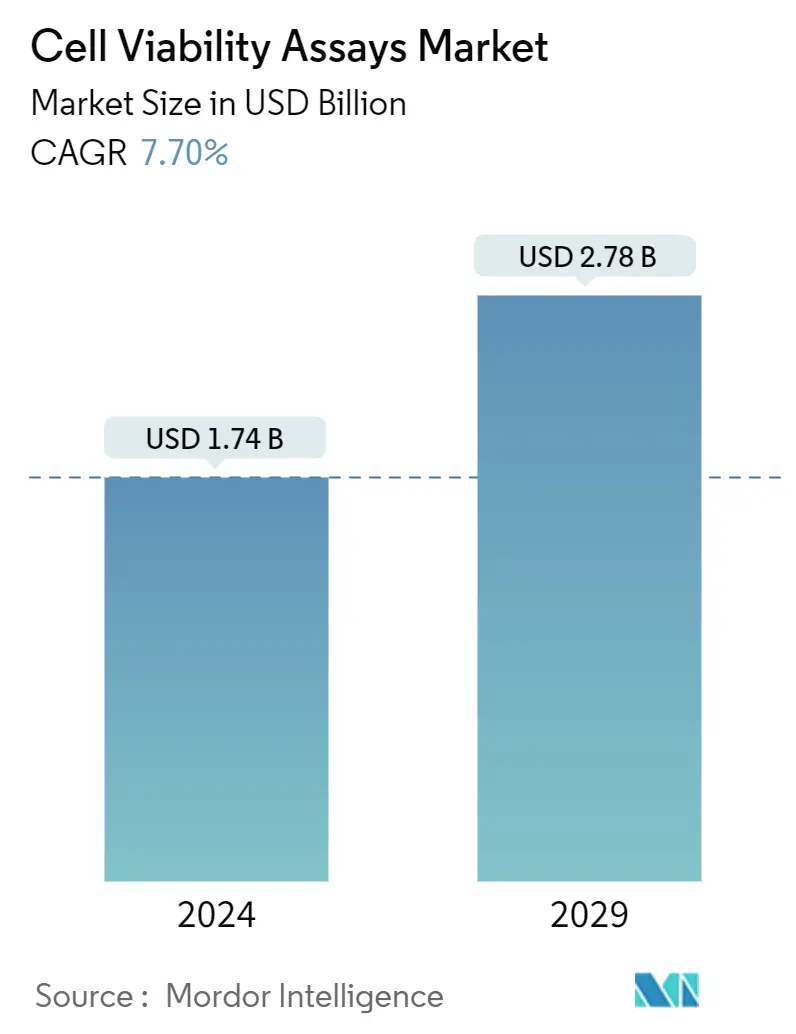
| Study Period | 2019 - 2029 |
| Market Size (2024) | USD 1.74 Billion |
| Market Size (2029) | USD 2.78 Billion |
| CAGR (2024 - 2029) | 7.70 % |
| Fastest Growing Market | Asia Pacific |
| Largest Market | North America |
Major Players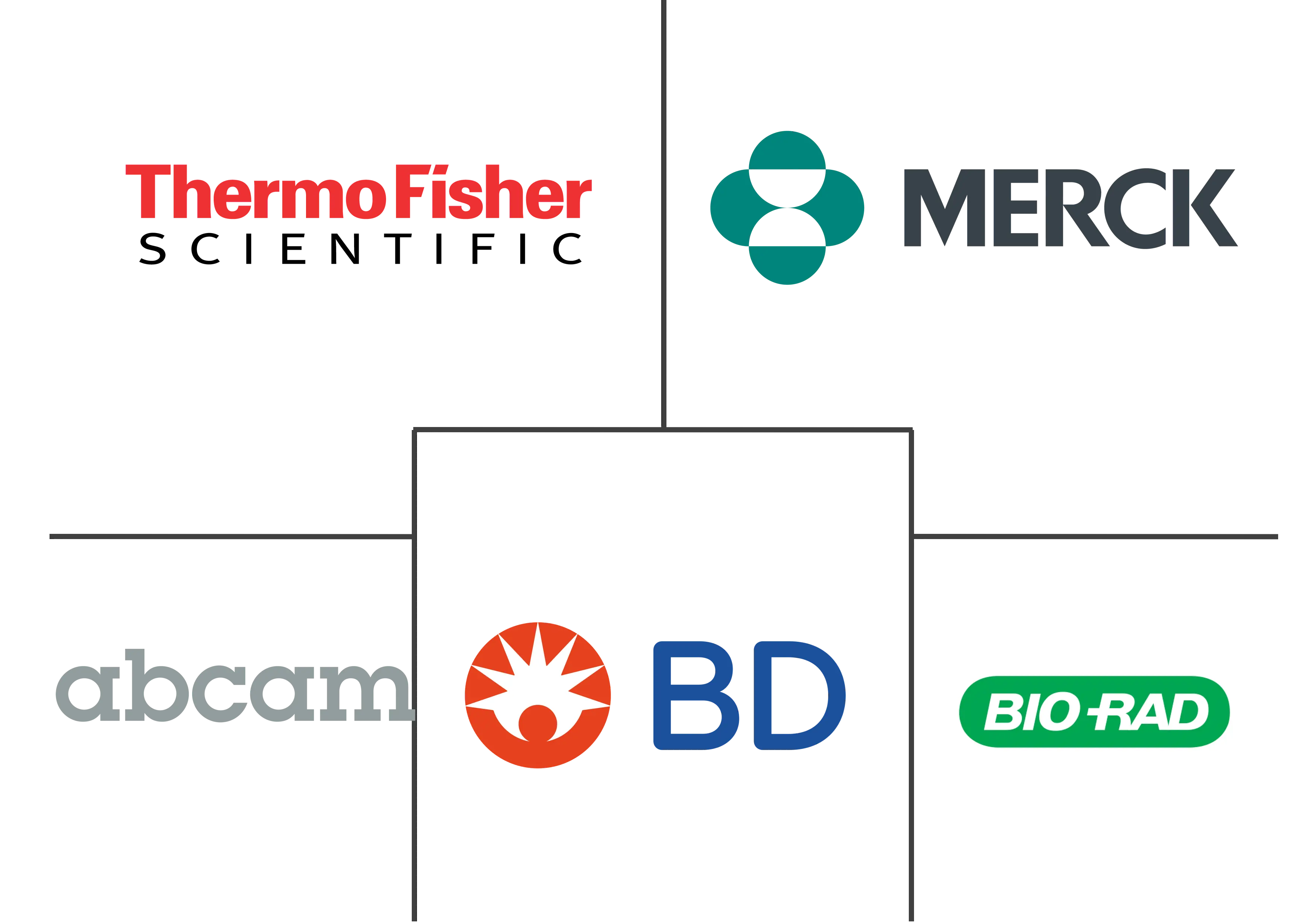
*Disclaimer: Major Players sorted in no particular order |
Cell Viability Assays Market Analysis
The Cell Viability Assays Market size is estimated at USD 1.74 billion in 2024, and is expected to reach USD 2.78 billion by 2029, growing at a CAGR of 7.70% during the forecast period (2024-2029).
The COVID-19 pandemic significantly impacted the growth of the cell viability assay market, as most companies focused on developing cell-based therapies for COVID-19 treatment. For instance, according to the study published in Stem Cell Research & Therapy volume in January 2022, stem cell therapy and stem cell-derived organoid models got much attention as a new treatment and research method for COVID-19, and stem cells played a role in the battle against COVID-19. With the increase in the need for stem cell therapies, there was to be an increase in the need for cell viability assays; hence, the market grew during the pandemic. However, as the pandemic has subsided, the studied market is expected to have stable growth during the forecast period of the study.
Factors such as the growing burden of chronic and infectious diseases, rising demand for cell-based assays in research, and increasing focus on developing cell-based therapeutics drive global market growth. Moreover, chronic diseases and conditions are on the rise worldwide, which is expected to further enhance the usage of cell viability assays. As per the International Diabetes Federation Diabetes Altas, in 2021, nearly 573 million adults were living with diabetes worldwide, and the number is expected to reach 643 million by 2030 and 783 million by 2045. As chronic disorders are on the rise, there is a huge demand for assays, which are helping in the faster treatment and timely detection of patients' conditions.
In emerging markets, cancer and heart diseases are becoming the main causes of death due to urbanization, sedentary lifestyles, changing diets, rising obesity levels, and widespread availability of tobacco products. For instance, according to an article published by PubMed Central in March 2022, China is experiencing a greater incidence of cancers. In 2022, there were expected to be approximately 4,820,000 new cancer cases in China, of which the most common is lung cancer. Hence, the high prevalence of chronic diseases such as cancer is expected to boost the adoption of cell viability assays to develop more innovative drugs.
Moreover, developing new cell viability assays to meet the rising demand is also a major factor driving the market growth. For instance, according to an article published by PubMed Central in May 2022, a novel cell viability assay was developed, which can check cellular viability in real-time using supervised machine learning and intracellular dynamic activity data acquired in a label-free, non-invasive, and non-destructive manner. Thus, the rising developments, such as novel cell viability assays, are also expected to boost market growth.
However, the limitations of the assays are expected to impede the market growth.
Cell Viability Assays Market Trends
Stem Cell Research Segment is Estimated to Register A Significant Growth Over the Forecast Period
The stem cell research segment is estimated to register significant growth, owing to the rising R&D activities and funding from various organizations. For instance, in June 2021, the Morrison Government invested USD 180 million in ground-breaking medical research projects around Australia to improve the lives of Australians. The source also stated that the investment was funded through the government's USD 20 billion Medical Research Future Fund, and 106 medical research projects will receive funding to improve health outcomes, including for Australians with cancer, dementia, brain injuries, heart problems, neurofibromatosis, and many others. Thus, the increasing investments in medical research, including stem cell research, are expected to boost the growth of the studied segment.
Technological advancements will play a significant role in the future, with multiple experiments in pluripotent stem cells being the center for exciting growth. For instance, in April 2022, researchers at Osaka University developed a biomaterial using stem cells to reverse intervertebral disk (IVD) degeneration associated with back pain and certain spinal issues. The stem cells were induced into chondrocytes -- cells producing collagen that supports cartilage tissue. Implanting this biomaterial into a rat model of IVD degeneration brought the spinal mechanical properties back to control levels, and this type of innovation will likely fuel market growth in future years.
Companies are raising funds to develop stem cell-based therapies to tackle many diseases. For instance, in January 2022, Cellino Biotech, a cell therapy manufacturing company, raised a USD 80 million Series A financing round. Cellino plans to expand access to stem cell-based therapies to build the first autonomous human cell foundry in 2025. As the applications of stem cell technologies in the treatment of diseases have ultimately increased, the overall adoption rate of cell viability assays worldwide.
Thus, considering all the factors above, such as the rising R&D activities and funding from various organizations, the studied segment is expected to witness high growth over the forecast period.
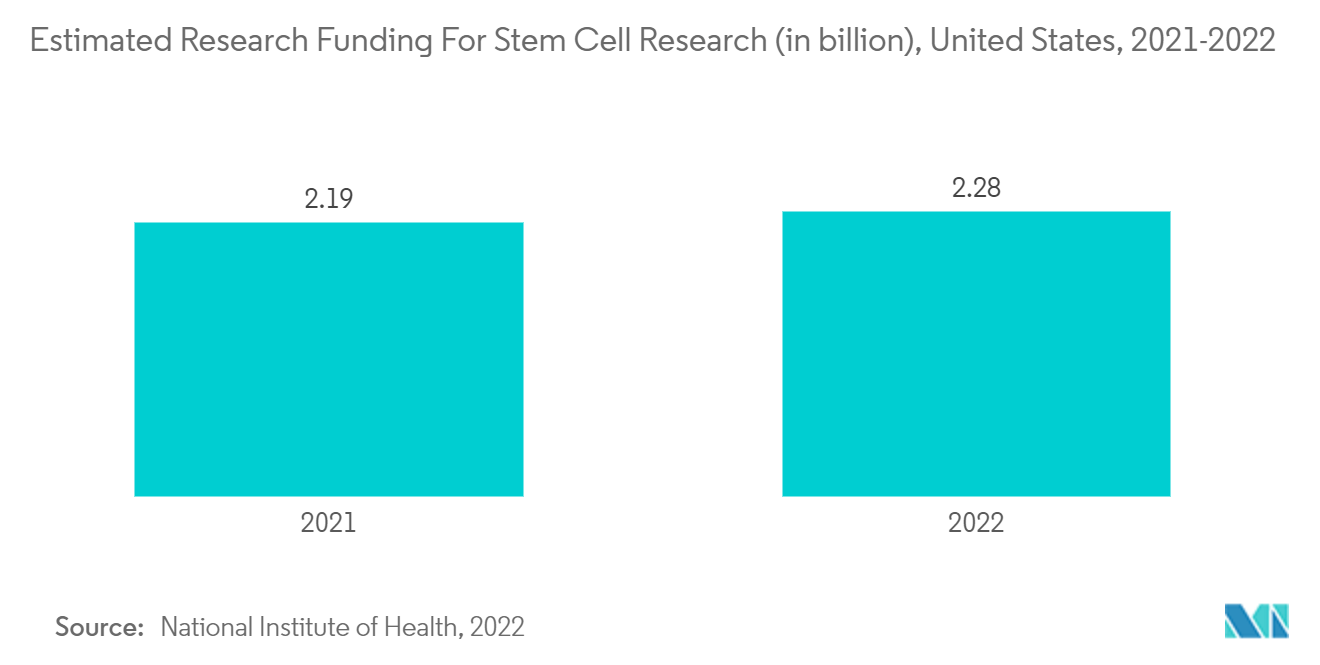
North America is Expected to Hold a Significant Share in the Market and Expected to do Same in the Forecast Period
North America holds a significant share of the cell viability assays market and is expected to witness a similar trend over the forecast period without significant fluctuations. The region is dominating the market due to various factors like the increasing incidences of chronic diseases, rise in cancer cases, rise in government investment initiatives, and high-quality infrastructure for clinical and laboratory research.
The United States is expected to increase its market share in the future, owing to the increased adoption of cancer therapy and the growing burden of cancers in the United States. According to the data in the Cancer Facts & Figures 2022 data published by the American Cancer Society, there would be an estimated 1.9 million new cancer cases in the United States in 2022, out of which 89,010 were expected to be lymphoma and 60,650 cases were expected to be leukemia.
Furthermore, according to the National Institute of Health, in May 2022, the estimated research funding for cancer was USD 7,362 million in the United States in 2021, and it increased to USD 7,644 million in 2022. The high investments in cancer research are also expected to boost the market's future growth.
Moreover, in March 2022, Promega Corporation and FUJIFILM Cellular Dynamics, Inc. announced a strategic collaboration to advance novel assay development for drug discovery. Under a multi-year licensing agreement, FUJIFILM Cellular Dynamics will offer a wide range of custom differentiated iPSCs integrated with Promega biosensor and intracellular bioluminescent reporter capabilities for researchers and scientists to use as part of novel assay development in the drug discovery process.
Furthermore, in the United States, there is a rise in funding for cell-based research, which is also expected to propel the overall growth of the cell viability assay market over the forecast period.
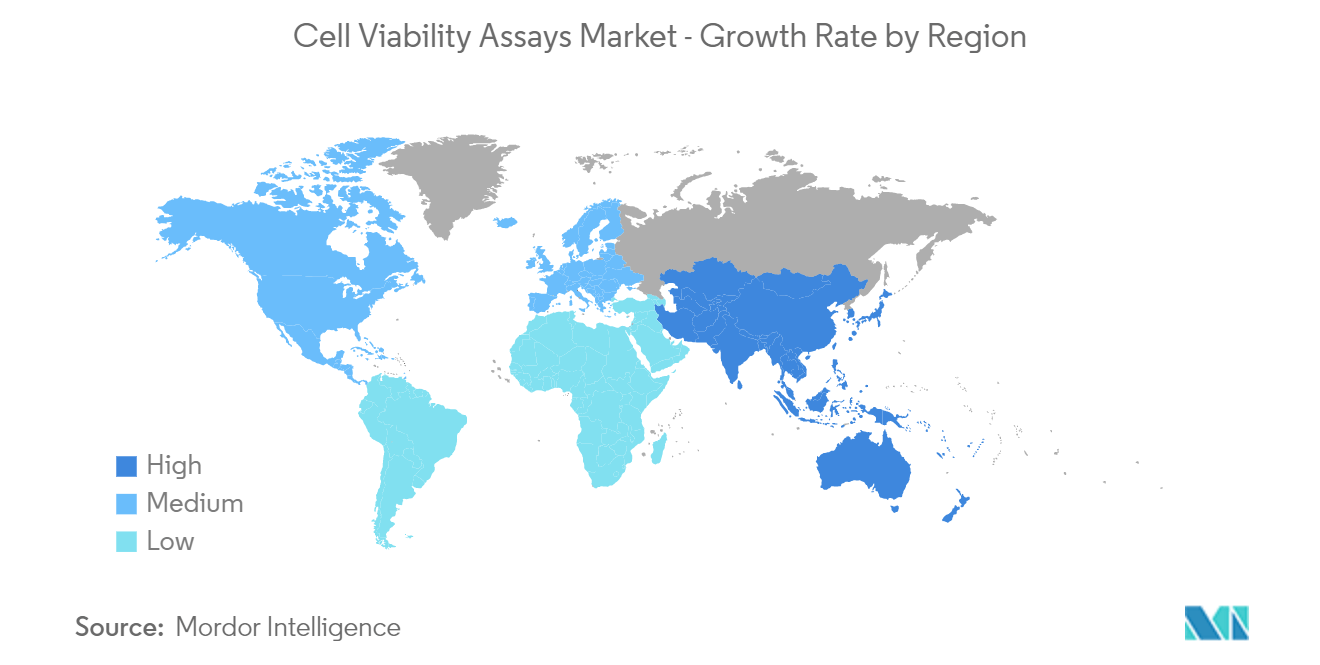
Cell Viability Assays Industry Overview
The cell viability assays market is fragmented and competitive owing to the presence of various small and large market players. Some of the market players are Abcam PLC, Becton Dickinson & Company, Bio-Rad Laboratories, Biotek Instruments, Creative Bioarray, GE Healthcare, Merck KGaA, Perkin Elmer, Promega Corporation, and Thermo Fischer Scientific Inc.
Cell Viability Assays Market Leaders
-
Thermo Fischer Scientific Inc.
-
Merck KGaA
-
Bio-Rad Laboratories
-
Becton Dickinson & Company
-
Abcam PLC
*Disclaimer: Major Players sorted in no particular order
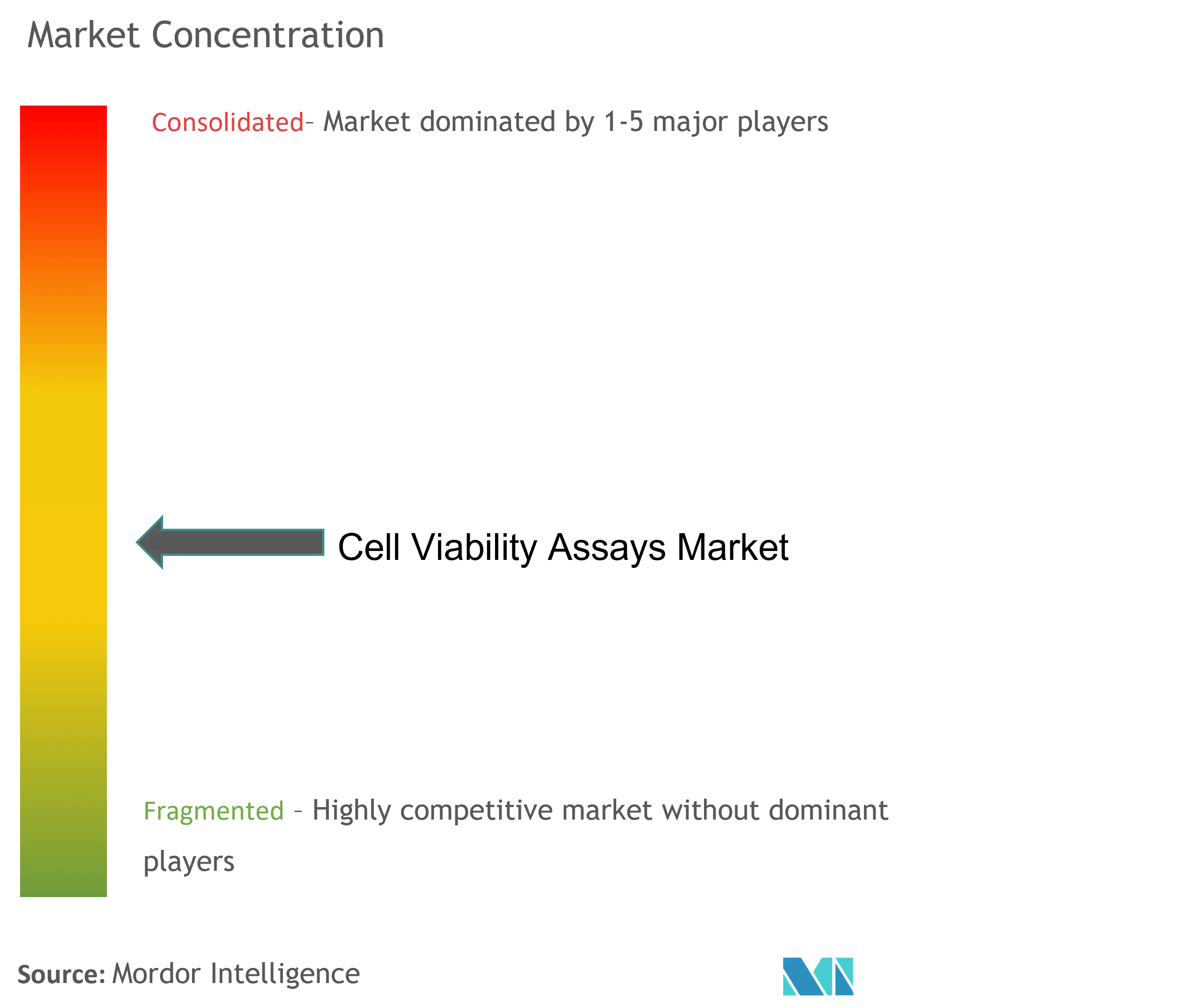
Cell Viability Assays Market News
- September 2022: Nanolive launched the LIVE Cell Death Assay, an automated solution for profiling cell health, death, apoptosis, and necrosis.
- March 2022: Biovica decided to establish a CLIA lab in San Diego, California. A location has been identified, and a lease for the premises has been signed. The lab will, after the clearance, offer DiviTumTKa-analysis to Biovica's customers in the United States.
Cell Viability Assays Market Report - Table of Contents
1. INTRODUCTION
- 1.1 Study Assumptions and Market Definition
- 1.2 Scope of the Study
2. RESEARCH METHODOLOGY
3. EXECUTIVE SUMMARY
4. MARKET DYNAMICS
- 4.1 Market Overview
-
4.2 Market Drivers
- 4.2.1 Growing Burden of Chronic and Infectious Diseases
- 4.2.2 Rising Demand for Cell-based Assays in Research
- 4.2.3 Increasing Focus on the Development of Cell-based Therapeutics
-
4.3 Market Restraints
- 4.3.1 Limitations of the Assays
-
4.4 Porter's Five Forces Analysis
- 4.4.1 Bargaining Power of Buyers/Consumers
- 4.4.2 Bargaining Power of Suppliers
- 4.4.3 Threat of New Entrants
- 4.4.4 Threat of Substitute Products
- 4.4.5 Intensity of Competitive Rivalry
5. MARKET SEGMENTATION (Market Size by Value - USD)
-
5.1 By Product
- 5.1.1 Consumables
- 5.1.1.1 Reagents
- 5.1.1.2 Assay Kits
- 5.1.1.3 Other Consumables
- 5.1.2 By Instruments
- 5.1.2.1 Automated Cell Counters
- 5.1.2.2 Flow Cytometers
- 5.1.2.3 Spectrophotometers
- 5.1.2.4 Other Instruments
-
5.2 By Application
- 5.2.1 Drug Discovery and Development
- 5.2.2 Stem Cell Research
- 5.2.3 Clinical and Diagnostic Applications
- 5.2.4 Other Applications
-
5.3 Geography
- 5.3.1 North America
- 5.3.1.1 United States
- 5.3.1.2 Canada
- 5.3.1.3 Mexico
- 5.3.2 Europe
- 5.3.2.1 Germany
- 5.3.2.2 United Kingdom
- 5.3.2.3 France
- 5.3.2.4 Italy
- 5.3.2.5 Spain
- 5.3.2.6 Rest of Europe
- 5.3.3 Asia-Pacific
- 5.3.3.1 China
- 5.3.3.2 Japan
- 5.3.3.3 India
- 5.3.3.4 Australia
- 5.3.3.5 South Korea
- 5.3.3.6 Rest of Asia-Pacific
- 5.3.4 Middle East and Africa
- 5.3.4.1 GCC
- 5.3.4.2 South Africa
- 5.3.4.3 Rest of Middle East and Africa
- 5.3.5 South America
- 5.3.5.1 Brazil
- 5.3.5.2 Argentina
- 5.3.5.3 Rest of South America
6. COMPETITIVE LANDSCAPE
-
6.1 Company Profiles
- 6.1.1 Abcam PLC
- 6.1.2 Becton Dickinson & Company
- 6.1.3 Bio-Rad Laboratories
- 6.1.4 Biotek Instruments
- 6.1.5 Creative Bioarray
- 6.1.6 GE Healthcare
- 6.1.7 Merck KGaA
- 6.1.8 Perkin Elmer
- 6.1.9 Promega Corporation
- 6.1.10 Thermo Fischer Scientific Inc.
- 6.1.11 Canvax Biotech
- 6.1.12 Creative Bioarray
- *List Not Exhaustive
7. MARKET OPPORTUNITIES AND FUTURE TRENDS
** Subject To AvailablityCell Viability Assays Industry Segmentation
As per the scope of this report, a cell viability assay is used to determine the ability of organs, cells, or tissues to maintain or recover viability. This type of assay can check the mechanical activity, motility, contraction, etc. Counting cells using viability dyes can provide both the proliferation rate and the percentage of viable cells. The cell viability assays market is segmented by product (consumables (reagents, assay kits, and other consumables), instruments (automated cell counters, flow cytometers, spectrophotometers, and other instruments)), application (drug discovery and development, stem cell research, clinical and diagnostic applications, and other applications), and geography (North America, Europe, Asia-Pacific, Middle-East and Africa, and South America). The market report also covers the estimated market sizes and trends for 17 countries across major global regions. The report offers the value (in USD) for the above segments.
| By Product | Consumables | Reagents |
| Assay Kits | ||
| Other Consumables | ||
| By Product | By Instruments | Automated Cell Counters |
| Flow Cytometers | ||
| Spectrophotometers | ||
| Other Instruments | ||
| By Application | Drug Discovery and Development | |
| Stem Cell Research | ||
| Clinical and Diagnostic Applications | ||
| Other Applications | ||
| Geography | North America | United States |
| Canada | ||
| Mexico | ||
| Geography | Europe | Germany |
| United Kingdom | ||
| France | ||
| Italy | ||
| Spain | ||
| Rest of Europe | ||
| Geography | Asia-Pacific | China |
| Japan | ||
| India | ||
| Australia | ||
| South Korea | ||
| Rest of Asia-Pacific | ||
| Geography | Middle East and Africa | GCC |
| South Africa | ||
| Rest of Middle East and Africa | ||
| Geography | South America | Brazil |
| Argentina | ||
| Rest of South America |
Cell Viability Assays Market Research FAQs
How big is the Cell Viability Assays Market?
The Cell Viability Assays Market size is expected to reach USD 1.74 billion in 2024 and grow at a CAGR of 7.70% to reach USD 2.78 billion by 2029.
What is the current Cell Viability Assays Market size?
In 2024, the Cell Viability Assays Market size is expected to reach USD 1.74 billion.
Who are the key players in Cell Viability Assays Market?
Thermo Fischer Scientific Inc., Merck KGaA, Bio-Rad Laboratories, Becton Dickinson & Company and Abcam PLC are the major companies operating in the Cell Viability Assays Market.
Which is the fastest growing region in Cell Viability Assays Market?
Asia Pacific is estimated to grow at the highest CAGR over the forecast period (2024-2029).
Which region has the biggest share in Cell Viability Assays Market?
In 2024, the North America accounts for the largest market share in Cell Viability Assays Market.
What years does this Cell Viability Assays Market cover, and what was the market size in 2023?
In 2023, the Cell Viability Assays Market size was estimated at USD 1.61 billion. The report covers the Cell Viability Assays Market historical market size for years: 2019, 2020, 2021, 2022 and 2023. The report also forecasts the Cell Viability Assays Market size for years: 2024, 2025, 2026, 2027, 2028 and 2029.
Cell Viability Assays Industry Report
Statistics for the 2024 Cell Viability Assays market share, size and revenue growth rate, created by Mordor Intelligence™ Industry Reports. Cell Viability Assays analysis includes a market forecast outlook to 2029 and historical overview. Get a sample of this industry analysis as a free report PDF download.



